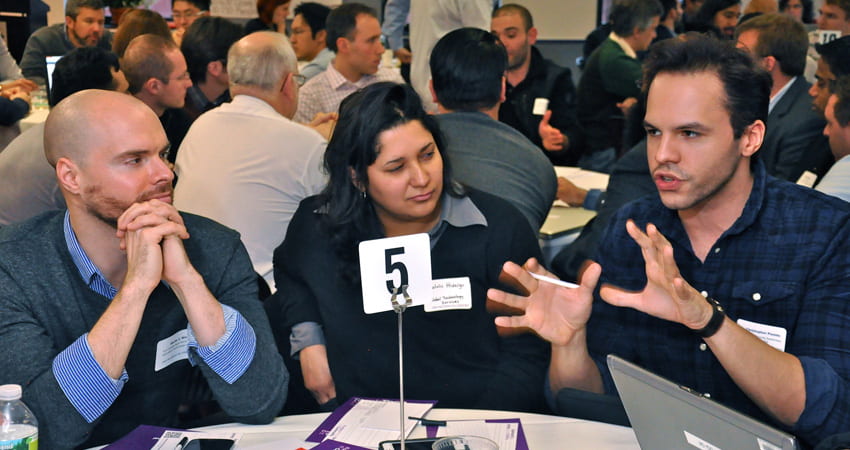
No Agenda on the Agenda
By Mark Macmurdo
On January 21, over 120 people from across the University came together for NYU’s first-ever IT “UnMeeting.” While it may have initially seemed like any other University-sponsored get together, when it was time to go over the agenda, it was immediately apparent things were going to be different.
That’s because there was no agenda. The format was based on the idea of “open space technology.” Advanced in the early 1980’s, this format has been used by many organizations as a bottom-up, rather than top-down, way to elicit engaging conversation. Instead of dictating all aspects of an event, meeting organizers merely provide the framework for participants.
After a brief introduction from meeting coordinator and Chair of the TorchTech Steering Committee Evan Silberman and Vice President of Global Technology Services Tom Delaney in which the guiding principles of the event were explained, the floor was opened to participants to volunteer topics for discussion. The idea was to get 26 topics: a topic for each of the 13 groups to discuss in two 45-minute sessions. It didn’t take long for participants to stand up and suggest their ideas. The whiteboard was soon filled with suggestions ranging from very specific topics (e.g., “centralized authentication” and “Salesforce and Drupal”) to much more general concepts (e.g., “content management” and “mobile”).
Once the topics had been determined, participants then had the freedom to break off to the table discussing whatever they found most interesting. Each table’s discussion was led by the person who proposed the topic. One additional member was tasked with recording notes, which were subsequently posted on the event’s website.
While the format of the event was largely open-ended, there were a few maxims that governed the discussions: “whoever comes are the right people” and “whatever happens is the only thing that could have happened.” Participants were also asked to abide by the “Law of Two Feet;” any person not learning from or contributing to the discussion must move on to another one.
What resulted were lively conversations from participants, all of whom seem engaged in the discussions they chose to join. Feedback was subsequently solicited through written and online evaluations. The results were overwhelmingly positive. One attendee even proclaimed that it was a “turning point in the University’s IT history.” However, there was one common complaint: many wished that the discussions lasted longer!
Planning across IT Communities
The UnMeeting was the first event ever hosted by TorchTech, a recently-formed University organization that describes itself as a vibrant “community-led group open to professionals at NYU who have an interest in technology.” The organization is run by a group of volunteers from across the University, and recently became a sponsored committee of the CIO Council (a group of school CIOs and IT Leaders from across NYU). “When we sat down to talk about the right forum, it was evident that an UnConference format was the only way to go,” says Silberman. NYU’s event was inspired in part by Stanford University’s IT UnConference.
The community aspect of the event was emphasized by those who spoke in the beginning and at the end of the event. While the participants came from all over the University—including many of NYU’s global sites—and had a wide range of backgrounds, they all shared one thing: a demonstrated interest in information technology and a desire to network with like-minded peers and colleagues.
In fact, participants were urged to start collaborating online before the event even began. By including a roster of attendees with their IT interests listed on the website, it enabled those who attended to start brainstorming about what they would like to discuss. They were also encouraged to engage on Twitter leading up to and during the conference.
The collaborative aspects of the conference were also apparent in how staff volunteered extra time to plan and organize the event. The website (www.nyu.edu/torchtech) was developed by Jonathan Rodriguez of the NYU Law School and designed by Shari Halter of the Tisch School of the Arts. The location at the Cantor Boardroom on the 11th floor of the Henry Kaufman Management and Education Center was provided by the Stern School of Business. Catering was provided by ITS. Volunteers included those from FAS, NYU Poly, Stern, Law, Tisch, Silver School of Social Work, NYU Abu Dhabi, NYU Libraries, Global Technology Services, and ITS.
More from TorchTech
According to Silberman, the UnMeeting was also useful because it gave organizers an idea of what people would like to get out of TorchTech moving forward. With a better sense of the communities’ interests, planning has begun for speakers, panel discussions, and other informal networking opportunities. In addition, TorchTech will hopefully serve as a place for NYU community members to connect outside of formal events. For information on future events or to get involved as a volunteer, please visit www.nyu.edu/torchtech.
Those involved are excited to keep the ball rolling. “The energy and creativity in the room was extraordinary,” Delaney says. “It was great to participate in this amazing event, spearheaded by TorchTech. I felt we held a glimpse of the future at NYU, and it was indeed a compelling vision that the community is beginning to shape.” Indeed, the first formal community of practice, IT Management Community of Practice, has already been established, and the next event, a moderated panel discussion on the Future of Cloud Computing, has been scheduled for June 26th (see sidebar).
For details and photographs from the January event, and for information about participating in TorchTech, whether as an attendee or volunteer, please visit the website. You are also invited to send questions and suggestions to torchtech-info@nyu.edu.





